Bulletin – June 2017 Australian Economy Australian Capital Flows
- Download 529KB
Abstract
Capital inflows have underpinned the expansion of Australia's productive capacity for the past 200 years or more. Recently, there have been three noteworthy changes in the composition of these flows. First, most inflows to the mining sector are now direct funding from offshore, rather than reinvested earnings. Second, foreign investors have been more actively managing their holdings of Australian government debt securities. Third, regulatory reforms have led to changes in banks' short-term debt funding.
Introduction
Over a long period of time, investment in the Australian economy has been greater than domestic saving. The difference has been made up by net capital inflows from abroad – the financial counterpart to the current account deficit (Graph 1). This has been possible because of the favourable risk-adjusted returns in Australia (Belkar, Cockerell and Kent 2007). Cross-border investment has played an important role in expanding the economy's productive capacity to meet growing demand for Australia's goods and services, such as during the recent mining investment boom. Australia's history of capital inflows reflects the net outcome of saving and investment decisions taken across all sectors of the Australian economy – by households, corporations and the general government sector – with these decisions affected by various domestic and international policy settings.[1]
Within Australia's history of net capital inflows, the underlying patterns have varied over time. As has been well documented, there were three notable developments between 2008 and 2013 (Graph 2) (Debelle 2014): (i) foreign direct investment in the mining sector during the investment boom increased; (ii) flows to the Australian banking sector declined from sizeable inflows in the lead-up to the global financial crisis, to around zero in the wake of the crisis; and (iii) foreigners increased their holdings of Australian government debt.
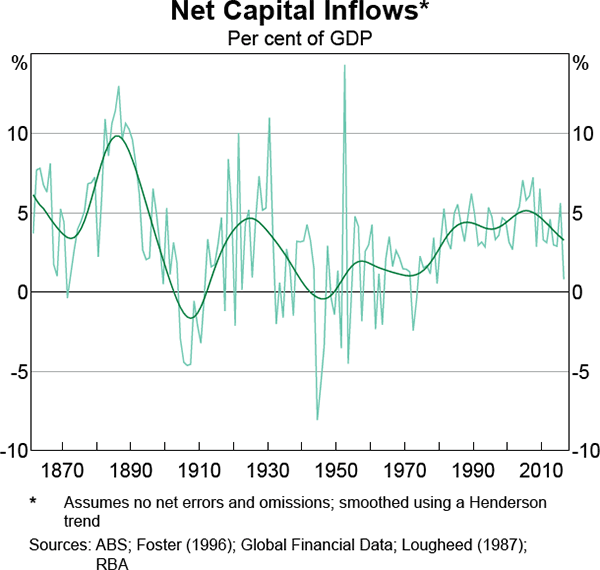

Although these trends have largely continued in recent years, there have been some notable changes in the composition of these net inflows (Table 1). This article discusses these changes in detail.[2] It also examines the historically large decline in the cost of servicing Australia's net foreign liability position, which itself represents the accumulation of net capital inflows and valuation effects.
Mining Sector
Private non-financial corporations have been the largest recipient of foreign capital inflows to Australia for much of the past decade, receiving almost 90 per cent of all net foreign capital inflows since 2008. A large share of these inflows has been to fund investment in the resource sector, during both the investment phase of the mining boom – which peaked in Australia in late 2012 – and as large parts of the sector shifted to the production and export phase (Graph 3).
During the mining investment boom, a significant share of the expansion in productive capacity was funded through foreign direct investment in the form of reinvested earnings – essentially calculated as profits less dividends.[3] This was during a period when profitability in the mining sector was very high (and dividends were relatively low) and reflected the tendency for the mining sector to fund investment from internal sources (Arsov, Shanahan and Williams 2013). As the mining sector has a high degree of direct foreign ownership, the increase in profits did not generate an equivalent increase in Australia's disposable income and saving as measured in the national accounts (and so the increase in domestic saving was not enough to fund the rapid increase in mining investment).[4] As such, there was a rise in the saving and investment gap of the non-financial corporate sector because of the mining sector (Graph 4).
| Average over: | |||
|---|---|---|---|
| 1998–2007 | 2008–13 | 2014–16 | |
| Private sector | 5.0 | 2.3 | 2.3 |
| Banks(b) | 5.4 | −0.2 | −0.5 |
| Other financials | −2.6 | −1. 2 | −0.4 |
| Other corporates | 2.2 | 3.4 | 3.0 |
| Mining sector | na | 1.7 | 2.4 |
| Public sector | −0.1 | 2.1 | 1.2 |
| Total | 5.0 | 4.4 | 3.5 |
|
(a) Excludes households and the RBA Sources: ABS; RBA |
|||
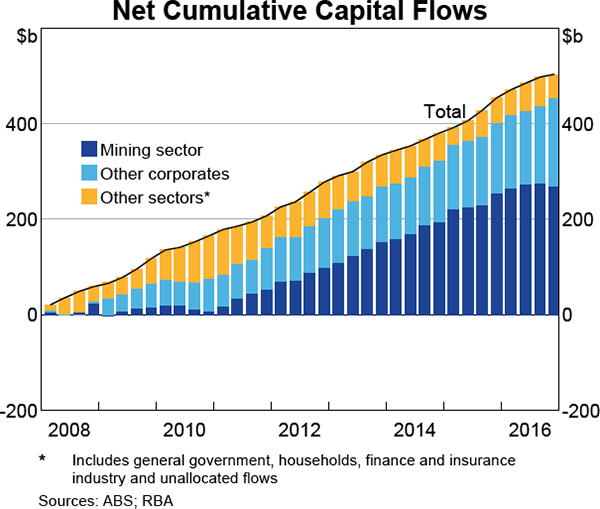
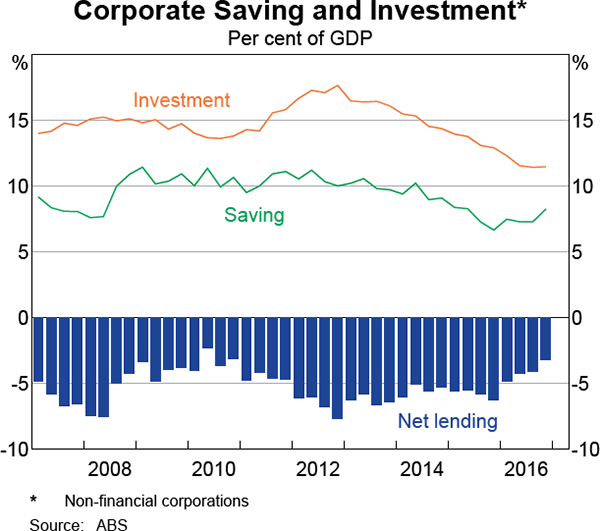
As the counterpart to this, there were increased net capital inflows to the mining sector. This is because in the balance of payments, these reinvested earnings are generally treated as if they were distributed to foreign owners according to their ownership share of the mining sector, which is high.[5] The foreign owners are then deemed to (notionally) reinvest back into the firm, which are recorded as capital inflows.[6] Strong capital inflows of this nature were observed over the period between 2008 and 2012. However, these were notional flows; reinvested earnings remain on business balance sheets in Australia for internal funding purposes and the money does not flow in and out of the country.
There have continued to be sizeable net inflows to the mining sector in recent years despite the substantial decline in mining investment (from 9½ per cent of GDP in 2012 to around 3½ per cent of GDP currently) and a decline in mining profits since the peak in commodity prices (Graph 5).
The continued capital inflows to the mining sector have been used to fund ongoing investment in large liquefied natural gas (LNG) projects. In recent years, LNG projects have made up a larger share of resource investment than previously and many of these projects have an even higher foreign ownership share than the overall sector. These LNG projects have typically involved new joint ventures where most participants are foreign entities and are likely to have limited existing domestic operations to generate profits to fund investment. Accordingly, these inflows have mostly been in the form of direct funding from offshore rather than reinvested earnings. In other words, money does actually flow into Australia.
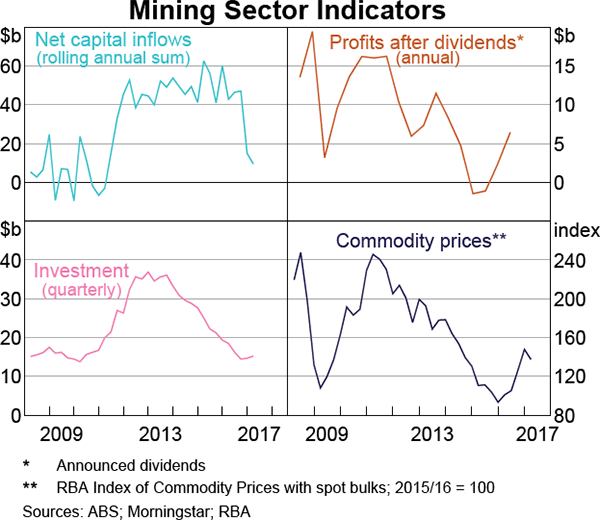
More recently, net capital inflows to the mining sector have started to taper off with the gradual transition of a number of large LNG projects from the investment phase into the production and export phase. Although the increase in exports will support profits, some of these profits are likely to be paid out to offshore owners as dividends rather than reinvested to further expand capacity.
Public Sector
In the public sector, foreigners have continued to increase their holdings of Australian government debt over the past couple of years. Ongoing purchases of Australian government debt have partly been supported by flows from Japanese investors since late 2013 (Graph 6). These flows were largely because of a policy-related fall in the yield on Japanese government bonds, which encouraged Japanese investors to shift into foreign alternatives. For instance, large segments of the Japanese asset management sector – such as Japan's Government Pension and Investment Fund – revised their asset allocation benchmarks to place a higher weight on international assets in their portfolios.

But flows into government bonds by foreign investors have moderated recently and have not kept pace with the increase in the issuance of these bonds by the Australian government.[7] The headline statistics show that the foreign ownership share of government bonds has declined by around 20 percentage points since its peak in 2012. While the share has indeed declined, the extent is overstated by this headline measure. Part of this decline is a reflection of foreigners more actively managing their government bond holdings, rather than a decreased appetite to hold Australian Government Securities (AGS). In particular, there has been an increase in collateralised lending of AGS by foreigners via repurchase agreements (repos) with Australian dealers.[8] Such lending activity increased from around $5 billion in early 2012 to around $30 billion currently.
The collateralised lending of AGS for Australian dollars (or repo activity) is captured in the balance of payments statistics as a sale of AGS by a foreigner to their domestic counterparty. This is despite economic ownership remaining with the foreign lender, who has the obligation to buy back identical securities at some stage in the future. Adjusting the level of foreign ownership to account for this collateralised lending shows that the decline in the foreign ownership share of AGS has been around 5 percentage points smaller than recorded (Graph 7).
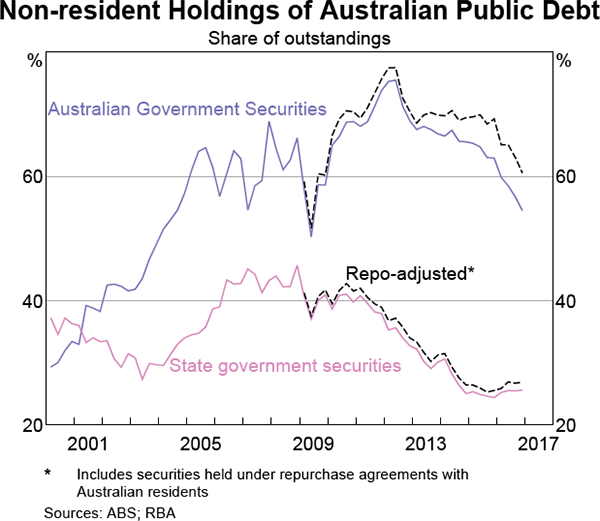
Foreigners started to more actively manage their AGS holdings over this period in part to take advantage of a trading opportunity in the foreign exchange market by swapping Australian dollars for Japanese yen (Becker, Fang and Wang 2016). Japanese institutional investors have been willing to pay a premium for foreign exchange – which is captured in the yen cross-currency swap basis (Graph 8).[9] This is because, as they diversify away from domestic assets and into foreign alternatives, they also want to hedge their exposure to foreign currency risk, which can be done using cross-currency swaps.
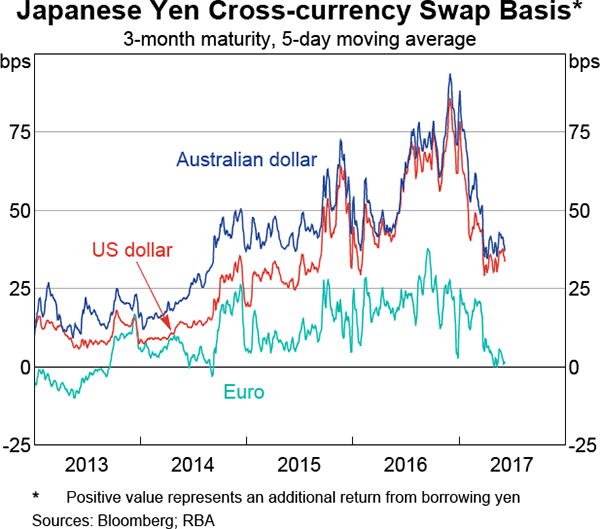
More recently, the attractiveness of this trading opportunity has declined, with the yen basis falling alongside a reduction in the demand for foreign currency assets from Japanese investors. Despite this, there has been continued demand for AGS from Japanese investors. The decline in the cost of borrowing Australian dollars in exchange for yen from a Japanese investor's perspective reflects the tight relationship between the Australian dollar borrowing cost and the US dollar borrowing cost. It may also indicate the possibility that Japanese asset managers may be investing in AGS unhedged, or only minimally hedged, against foreign currency risk.
Banking Sector
The aggregate pattern of capital flows to the banking sector has not changed materially in recent years following the shift in banks' funding towards domestic deposits and away from offshore wholesale debt that occurred in the wake of the global financial crisis. There have been minimal net capital flows to or from the banking sector over the past decade, with the funding composition of banks remaining very stable (see Graph 8 in Atkin and Cheung (2017)).
Notwithstanding this stability, there have been two noteworthy developments relating to short-term debt, both stemming from regulatory reforms. First, over the past year or so, Australian banks have reduced their short-term debt issuance in preparation for the introduction of the Net Stable Funding Ratio (NSFR) next year (Graph 9). The NSFR provides an incentive for banks to shift to sources of funding considered to be more stable and away from sources such as short-term wholesale liabilities.
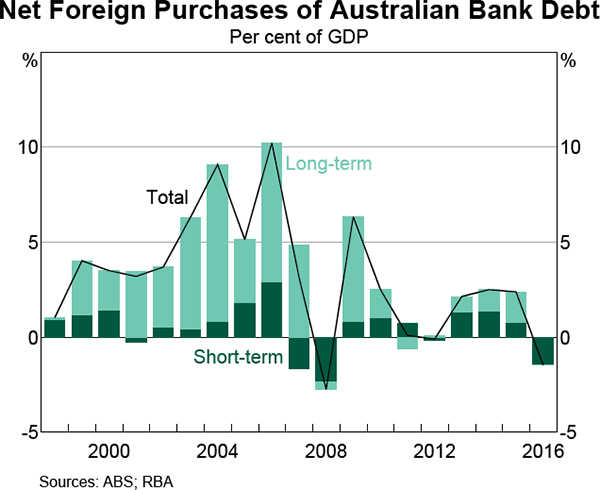
Second, international regulations have brought about a shift in the type of offshore investors that are funding Australian banks' short-term issuance. In particular, in the lead-up to the implementation of US money market fund (MMF) reforms by the US Securities and Exchange Commission in October 2016, the value of assets under management of prime MMFs (those that lend to banks) fell by US$1 trillion or around 70 per cent. Of this, holdings of Australian bank debt declined by around US$70 billion (Graph 10). In the midst of this decline, prime MMFs maintained the same share of their exposure to Australian banks relative to banks globally (at around 8 per cent of total MMF exposures to banks), but the absolute size of the decline was notable.
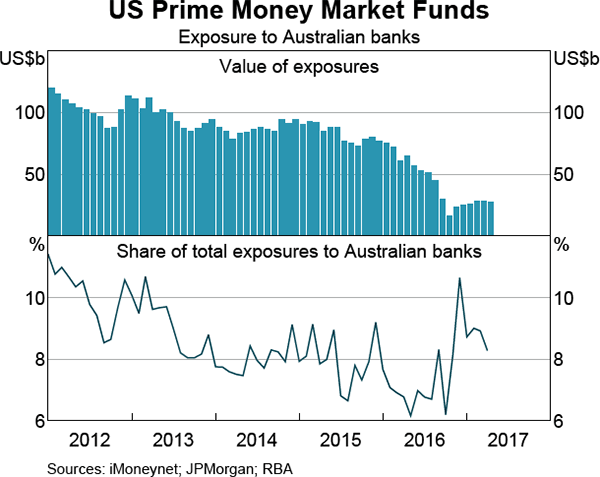
Nonetheless, Australian banks have been able to source funds from other investors with large cash holdings, such as US corporations in the technology sector. Accordingly, the short-term funding that Australian banks raise in commercial paper markets did not decline significantly in aggregate despite this shift in the investor base. The ability of Australian banks to readily find alternative investors for their short-term paper partly reflects the attractiveness of Australian bank paper from a risk-reward perspective.
Australia's Net Foreign Liability Position
Australia's net foreign liability position measures the stock of Australia's foreign liabilities relative to the stock of Australian's holdings of foreign assets (Graph 11). As such, it represents the accumulation of Australia's net capital inflows and so will be affected by the flows discussed above as well as by relative asset price changes. When measured as a share of GDP, Australia's net foreign liability position was relatively stable for more than a decade to 2015, before increasing slightly more recently to be around 60 per cent of GDP.
Despite the relative stability in the aggregate position, there have been changes in the sectoral net liability positions, which largely mirror the trends in capital flows. Over the past decade or so, the public sector's gross foreign liabilities have increased (by the equivalent of 14 percentage points of GDP to around 20 per cent of GDP) as has the stock of mining sector liabilities (by the equivalent of 20 percentage points of GDP over this period to be currently equivalent to about 25 per cent of GDP). For the banking sector, an increase in foreign liabilities has been offset by an increase in the stock of foreign assets held by banks, such that the net liability position has declined a little. In contrast to the other sectors, other financial corporations have a net foreign asset position, reflecting Australian superannuation funds' large holdings of foreign assets.
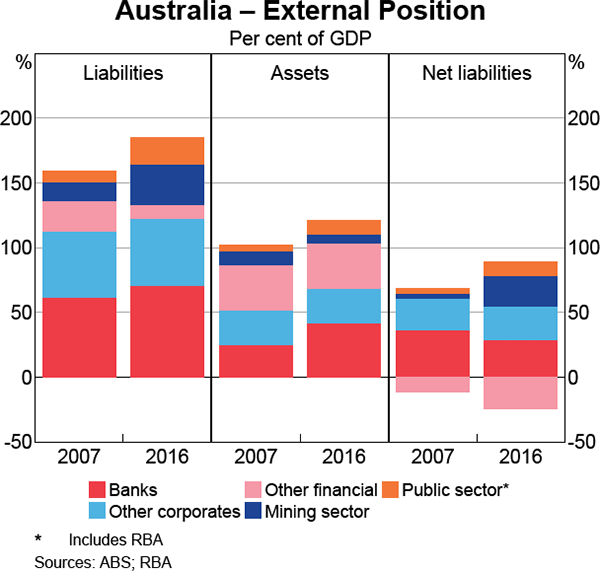
Valuation effects have also been important (Graph 12). Over the period between 2008 and 2014, relative asset price movements improved Australia's net foreign liability position. The value of Australia's foreign assets increased by more than the value of foreigner's holdings of Australian assets; for example, the S&P 500 US stock market index increased by around 25 per cent relative to a decline in the ASX 200 Australian stock market index of around 15 per cent over this period (Table 2). However, in recent years relative asset price movements have mostly contributed to an increase in the net foreign liability position. This was mostly driven by the increase in the value of Australian government debt over the period between 2014 and 2016; the yield on long-term AGS (which moves inversely to its price) declined by around 150 basis points, compared with a decline of around 60 basis points on US Treasuries with the same maturity.
| S&P 500 | ASX 200 | 10-year US Treasury |
10-year AGS | USD per AUD | AUD TWI | |
|---|---|---|---|---|---|---|
| Per cent | Per cent | bps | bps | Per cent | Per cent | |
| 2008–14 | 25.9 | −15.6 | −100 | −209 | 1.5 | 0.3 |
| 2014–16 | 21.1 | 5.9 | −58 | −147 | −19.1 | −7.2 |
|
Source: Bloomberg |
||||||
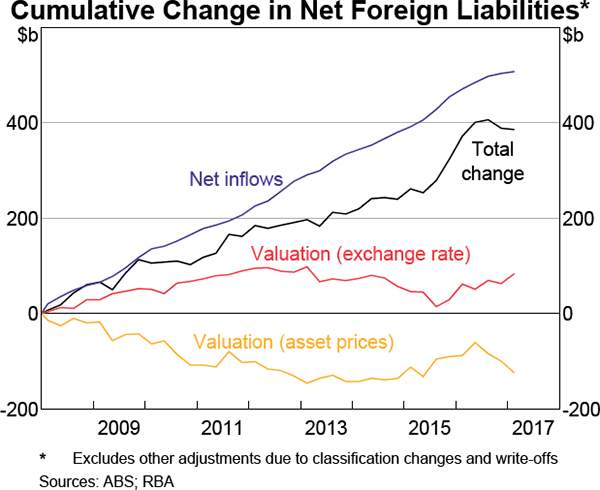
Fluctuations in the exchange rate have had a less pronounced effect on the foreign liability position over the past decade. The majority of Australian entities' foreign liabilities are denominated in Australian dollars, whereas most foreign assets are denominated in foreign currency, resulting in a net foreign currency asset position. As a result, a depreciation of the exchange rate tends to increase net assets measured in Australian dollar terms. The net foreign currency asset position is even more pronounced after hedging is taken into account. The broad-based appreciation of the Australian dollar (associated with the terms of trade and mining investment boom) to its peak in 2013 contributed to an increase in the foreign liability position, but this move was retraced as the Australian dollar depreciated.
In recent years, Australia's net debt liabilities have in fact been larger than its total net liabilities, given the shift to a small net equity asset position (Graph 13). Over 2013 to the end of 2016, the level of Australian investment in foreign equity exceeded the level of foreign investment in Australian equity. This was due to ongoing offshore equity investments by the Australian superannuation sector as well as the valuation effects mentioned earlier.
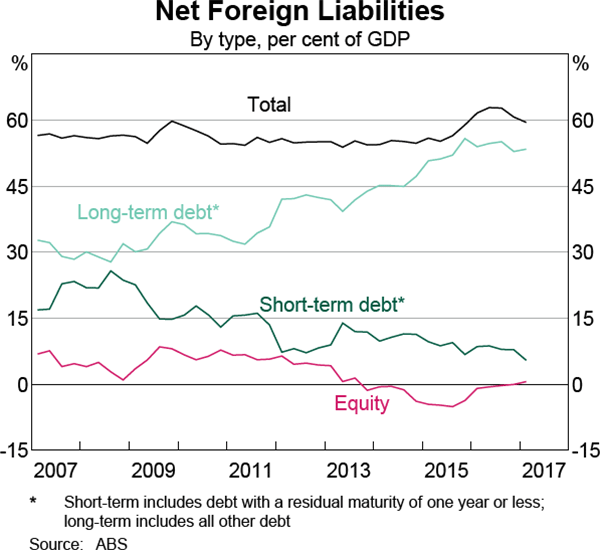
The share of Australia's foreign debt liabilities that is long term has risen noticeably over the past decade. Long-term debt liabilities have increased from around 30 per cent before the financial crisis to be around 50–55 per cent of GDP. The shift towards longer-term debt after the crisis was a result of two factors: banks lengthening the maturity of their debt on issue as well as the shift from bank debt towards government debt, which tends to have a relatively longer maturity (Stewart, Robertson and Heath 2013). Short-term debt liabilities are around their lowest share of GDP in over two decades.
Net Income Deficit
The net income deficit (NID) measures the cost of servicing the net liability position through interest payments and receipts on debt as well as dividends or reinvested earnings for equity. Australia has had an NID since at least 1960, which is a direct artefact of the net foreign liability position. It reflects the fact that the income paid on foreign holdings of Australian assets (such as interest paid by Australian banks on their foreign borrowings) is larger than the income received on Australian holdings of foreign assets (such as dividend income earned by Australian superannuation funds on their holdings of foreign equities).
The NID depends on two things: the stock of foreign assets and liabilities and the average yield paid on these positions. Accordingly, Australia's ongoing NID also reflects Australia's overall negative yield differential, with the yield received on Australian foreign assets lower than the yield paid to foreigners on their investments in Australia (Graph 14). For debt securities, the negative yield differential partly reflects the longer maturity of Australian liabilities compared with its foreign assets.[10] For equity liabilities, the negative yield differential is partly a reflection of taxation policies, particularly Australia's system of dividend imputation, which encourages higher dividend payout ratios. Australian companies' dividends are generally high by international standards (Bergmann 2016).[11]

From late 2010 to early 2016, Australia's NID narrowed to be around its lowest level as a per cent of GDP since the Australian dollar was floated (Graph 15). This narrowing, as well as the recent shift in the trade balance to a surplus, has led to the narrowing of the current account deficit to its lowest share of GDP since the early 1980s. There were two distinct periods behind the decline in the NID, with different drivers in each period.
The narrowing in the NID from late 2010 to late 2013 was mostly because of a decline in income payments on Australia's foreign debt and equity liabilities (Ma 2014) (Graph 16). The lower average yield paid on Australian foreign debt was due to both a decrease in Australian interest rates and an increase in the share of Australia's foreign debt owed by the Australian Government (which pays a lower interest rate than private sector borrowers). At the same time, lower profitability of the mining sector led to a decline in payments on equity liabilities. A reduction in the profitability of the mining sector – which is majority foreign owned – gives rise to smaller payments to the foreign owners (either in the form of dividend payments or reinvested earnings) and accordingly reduces the NID.
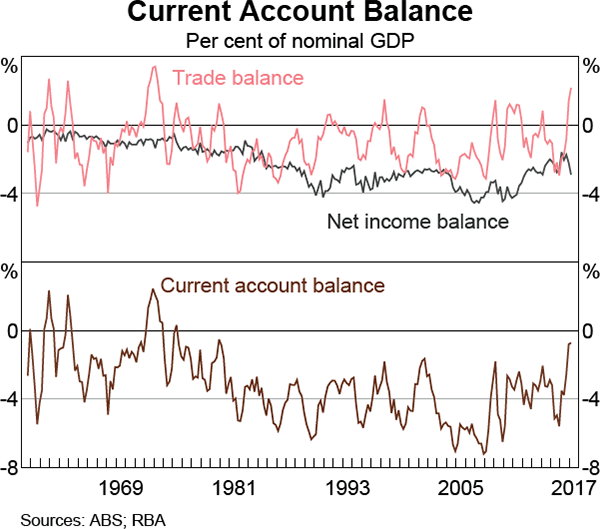
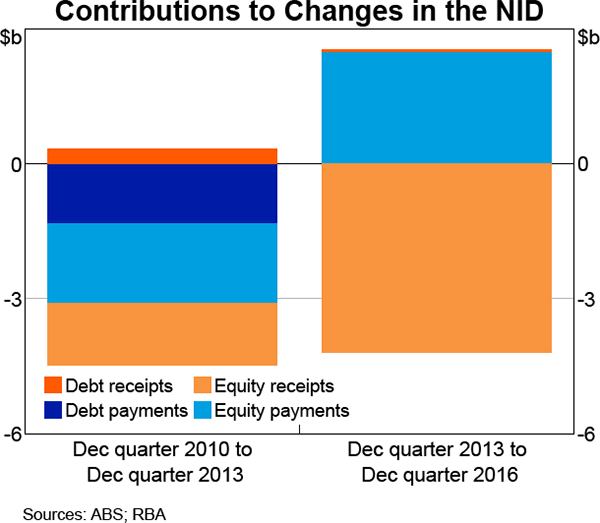
In contrast, the narrowing in the NID since 2013 has been a result of an increase in the income received on Australia's foreign equity holdings (Graph 16). This increase in income is because of the continued flows into offshore equity by Australian superannuation funds and the depreciation of the exchange rate over this period (which increases the Australian dollar value of dividend receipts) (Graph 17).
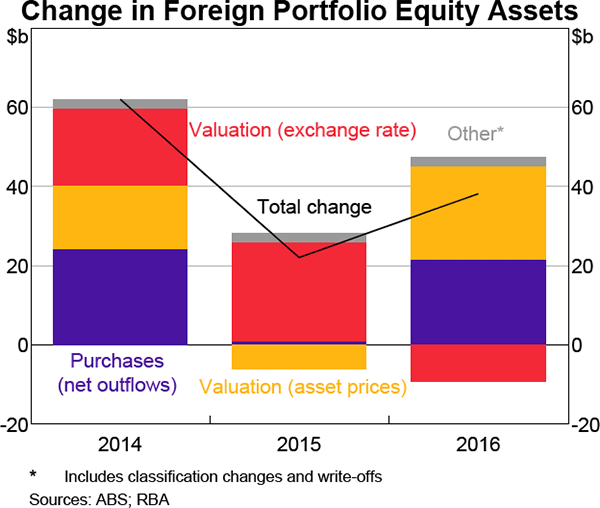
This is illustrated by the rise in the stock of foreign portfolio equity holdings by Australian residents. These holdings increased by around $120 billion between the December quarter 2013 and the December quarter 2016. A little less than half of this increase owed to net purchases of portfolio equity. The remainder was due equally to price changes and the depreciation of the exchange rate over the period. Australian Prudential Regulation Authority data allow us to map this increase to the superannuation industry. These data indicate that the value of international listed equity held by the superannuation industry increased by almost the same amount as the stock of portfolio equity recorded over the same period in the balance of payments (that is, around $120 billion) suggesting that most of the increase in the stock of portfolio equity was due to the superannuation industry.
In the second half of 2016 and into 2017 the NID has widened, partly in response to the recent boost to mining sector profitability from the recent increase in commodity prices (which has been partly unwound and which is not expected to persist). It appears that some of these profits were paid out to foreign owners as dividends, based on company announcements. In contrast with previous periods of high profitability this temporary boost to profitability is not likely to be used to fund further investment.
Conclusion
To a large extent, trends in capital flows have been broadly unchanged over the past decade following substantial shifts in foreign investment to fund the mining investment boom and in the wake of the financial crisis. But, underlying this, there have been some notable changes in the composition of flows in recent years. First, although mining capital inflows have continued, much of the recent inflows have been (actual) transfers from offshore, as opposed to the (notional) flows associated with reinvested earnings during the mining investment boom. Second, foreign investors have continued to increase their holdings of Australian government debt, but more active management has implications for the measurement of these holdings. And third, although there has continued to be little net capital flows either to or from the banking sector, regulatory reforms have resulted in changes in the composition of short-term debt funding in recent years. Continued net capital inflows have led to a moderate rise in Australia's net foreign liability position as a share of GDP. Nevertheless, the cost of servicing the net liability position has declined to historically low levels. In recent years, this has been because of an increase in income received from the ongoing investment in offshore equity by superannuation funds as well as valuation effects, which have boosted the stock of offshore equity holdings.
Footnotes
The authors are from International Department. [*]
For a detailed discussion of sectoral trends in national saving and investment in the Australian economy, see Bishop and Cassidy (2012). [1]
This article expands upon many of the issues explored in Debelle (2017). [2]
Specifically, under international balance of payments standards, reinvested earnings are calculated as net income (after tax and depreciation) less dividends less holding gains plus bad debt provisions. [3]
For example, national corporate saving will only include half of the earnings retained by a mining company that is 50 per cent owned by foreign direct investors. The remaining earnings are paid overseas as ‘reinvested earnings’. [4]
A range of estimates place this share at between 60–80 per cent, depending in part on the composition of the mining sector at any given time; the foreign ownership share for iron ore producers tends to be lower than the foreign ownership shares of coal and liquefied natural gas (LNG) producers. [5]
Specifically, reinvested earnings that accrue to foreign owners that are direct investors (owning sufficient shares to have an effective voice in the decisions of the firm) appear as a notional income flow out of Australia in the net income component of the current account, along with an offsetting financial inflow for the notional reinvestment of these earnings. This treatment ensures international consistency. A controlling foreign owner's decision regarding the level of net income that is reinvested, or distributed as dividends, can vary significantly across jurisdictions due to different policy settings. If reinvested earnings were not attributed to controlling foreign owners in this way, then a jurisdiction with a higher level of reinvested earnings (for example, due to taxation policies) would also record a higher level of national saving. [6]
Correspondingly, the share of Australian government debt held by residents – specifically, local banks – has increased. The increase in domestic holdings of Australian government debt is almost entirely attributable to meeting prudential requirements – in particular the Liquidity Coverage Ratio, which requires banks to hold sufficient high-quality liquid assets to withstand a 30-day period of stress. [7]
Repos involve the transfer of a security for cash with an undertaking to reverse the transaction at an agreed future date and price. [8]
For a useful explainer on the mechanics of foreign currency swaps and cross-currency basis swaps, see Baba, Packer and Nagano (2008, p 82). [9]
The implied average yield understates the actual cost of foreign currency borrowing as it excludes the cost of hedging foreign exchange risk; these costs are accounted for elsewhere in the balance of payments. [10]
It is important to note that higher nominal payments on liabilities compared to assets need not necessarily imply a loss of wealth. For example, over the long run, relatively low dividend flows to Australian holders of foreign equity assets would tend to be associated with higher revaluation gains for Australian holders of those assets. [11]
References
Arsov I, B Shanahan and T Williams (2013), ‘Funding the Australian Resources Investment Boom’, RBA Bulletin, March, pp 51–61.
Atkin T and B Cheung (2017), ‘How Have Australian Banks’ Responded to Tighter Capital and Liquidity Requirements?’, RBA Bulletin, June, pp 41–50.
Baba N, F Packer and T Nagano (2008), ‘The Spillover of Money Market Turbulence to FX Swap and Cross-currency Swap Markets’, BIS Quarterly Review, March pp 73–86.
Becker C, A Fang and JC Wang (2016), ‘Developments in the Australian Repo Market’, RBA Bulletin, September, pp 41–46.
Belkar R, L Cockerell and C Kent (2007), ‘Current Account Deficits: The Australian Debate’, RBA Research Discussion Paper No 2007–02.
Bergmann M (2016), ‘The Rise in Dividend Payments’, RBA Bulletin, March, pp 47–56.
Bishop J and N Cassidy (2012), ‘Trends in National Saving and Investment’, RBA Bulletin, March, pp 9–18.
Debelle G (2014), ‘Capital Flows and the Australian Dollar’, Speech to the Financial Services Institute of Australia, Adelaide, 20 May.
Debelle G (2017), ‘Recent Trends in Australian Capital Flows’, Speech to the Australian Financial Review Banking and Wealth Summit, Sydney, 6 April.
Foster R (1996), ‘Australian Economic Statistics 1949–50 to 1994–95’, Reserve Bank of Australia Occasional Paper 8.
Lougheed A (1987), ‘International Transactions and Foreign Commerce’, in W Vamplew (ed), Australians: Historical Statistics, Fairfax, Syme & Weldon Associates, pp 183–209.
Ma S (2014), ‘Why Has the Net Income Deficit Narrowed?’, RBA Bulletin, June, pp 19–26.
Stewart C, B Robertson and A Heath (2013), ‘Trends in the Funding and Lending Behaviour of Australian Banks’, RBA Research Discussion Paper No 2013–15.